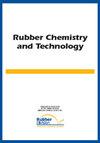ADDITIVE MANUFACTURING AND VULCANIZATION OF CARBON BLACK–FILLED NATURAL RUBBER–BASED COMPONENTS
IF 1.5
4区 工程技术
Q4 POLYMER SCIENCE
引用次数: 3
Abstract
Additive manufacturing of thermoplastics or metals is a well-approved sustainable process for obtaining rapidly precise and individual technical components. Except for crosslinked silicone rubber or thermoplastic elastomers, there is no method of additive manufacturing of elastomers. Based on the development of the additive manufacturing of elastomers (AME) process, the material group of rubber-based cured elastomers may gain first access to the process field of three-dimensional (3D) printing. Printing and crosslinking of rubber is separated into two steps. In the first step, printing is realized by extrusion of the rubber by using a twin-screw extruder, which works according to the derived fused-filament-fabrication principle. In the second step, the component is vulcanized in a high-pressure hot-air autoclave. Because of the plastic flow behavior of non–crosslinked rubber materials, a thermoplastic shell is probably needed to maintain the geometry and position of the additively manufactured rubber. In this way, one layer of thermoplastic and one layer of rubber are printed alternatingly until the component is finished. Afterward, the manufactured binary component is placed in an autoclave to obtain the elastomer after vulcanization under a hot-air and high-pressure atmosphere. Then, the thermoplastic shell is removed from the elastomer and can subsequently be recycled. As compared with conventional thermoplastics, the high viscosity of rubber during processing and its instable shape after extrusion are challenging factors in the development of the AME. This contribution will show a modified 3D printer; explain the printing process from the designed component, via shell generation, to the vulcanized component; and show first printed components.炭黑填充天然橡胶基组件的增材制造和硫化
热塑性塑料或金属的增材制造是一种获得广泛认可的可持续工艺,用于快速获得精确和单独的技术部件。除了交联硅橡胶或热塑性弹性体外,没有增材制造弹性体的方法。基于弹性体增材制造(AME)工艺的发展,橡胶基固化弹性体的材料组可能首先进入三维(3D)打印工艺领域。橡胶的印刷和交联分为两个步骤。在第一步中,通过使用双螺杆挤出机挤出橡胶来实现印刷,该挤出机根据衍生的熔融丝制造原理工作。在第二步中,在高压热风高压釜中对部件进行硫化。由于非交联橡胶材料的塑性流动行为,可能需要热塑性外壳来保持添加制造的橡胶的几何形状和位置。通过这种方式,一层热塑性塑料和一层橡胶交替印刷,直到部件完成。然后,将制造的二元组分置于高压釜中,以获得在热空气和高压气氛下硫化后的弹性体。然后,将热塑性外壳从弹性体中移除,并且随后可以再循环。与传统的热塑性塑料相比,橡胶在加工过程中的高粘度和挤出后的不稳定形状是AME发展的挑战因素。此贡献将展示一台经过修改的3D打印机;解释从设计组件到外壳生成再到硫化组件的印刷过程;并且示出了第一印刷部件。
本文章由计算机程序翻译,如有差异,请以英文原文为准。
求助全文
约1分钟内获得全文
求助全文
来源期刊

Rubber Chemistry and Technology
工程技术-高分子科学
CiteScore
3.50
自引率
20.00%
发文量
21
审稿时长
3.6 months
期刊介绍:
The scope of RC&T covers:
-Chemistry and Properties-
Mechanics-
Materials Science-
Nanocomposites-
Biotechnology-
Rubber Recycling-
Green Technology-
Characterization and Simulation.
Published continuously since 1928, the journal provides the deepest archive of published research in the field. Rubber Chemistry & Technology is read by scientists and engineers in academia, industry and government.
 求助内容:
求助内容: 应助结果提醒方式:
应助结果提醒方式:


